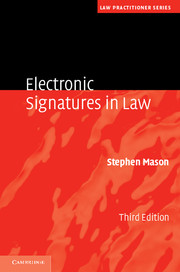Book contents
- Frontmatter
- Contents
- Preface
- Acknowledgements
- Table of cases
- 1 The signature
- 2 International initiatives
- 3 European Union Directive on electronic signatures
- 4 England and Wales, Northern Ireland and Scotland
- 5 International comparison of electronic signature laws
- 6 The form of an electronic signature
- 7 Digital signatures
- 8 Liability
- 9 Evidence
- 10 Data protection
- Index
- References
9 - Evidence
- Frontmatter
- Contents
- Preface
- Acknowledgements
- Table of cases
- 1 The signature
- 2 International initiatives
- 3 European Union Directive on electronic signatures
- 4 England and Wales, Northern Ireland and Scotland
- 5 International comparison of electronic signature laws
- 6 The form of an electronic signature
- 7 Digital signatures
- 8 Liability
- 9 Evidence
- 10 Data protection
- Index
- References
Summary
In the event an electronic signature becomes the subject of a dispute, the normal considerations will apply regarding the submission of evidence into legal proceedings, including any rules relating to the authentication of the evidence, the weight to be given to the evidence and whether it is necessary to help the adjudicator in reaching a decision by providing expert witnesses. This chapter aims to alert the reader to some of the issues that might arise in relation to electronic signatures, although the emphasis is on digital signatures.
The evidence forming a digital signature
A certificate is issued with a digital signature, which is a signed data structure that binds a public key to an identity. This certificate will purport to bind the public key to the information contained in the certificate. The subscribing party provides some of the information contained in the certificate, which may or may not be verified by the certification authority, and the certification authority is responsible for the remaining information. The subscriber will have a pair of keys, private and public. The key pairs may be generated by the keying material available to the subscribing party in their computer, by a registration authority, by the certification authority or by a trusted third-party key generation facility.
- Type
- Chapter
- Information
- Electronic Signatures in Law , pp. 314 - 347Publisher: Cambridge University PressPrint publication year: 2012

